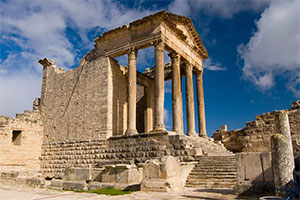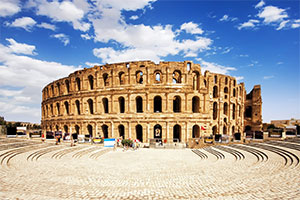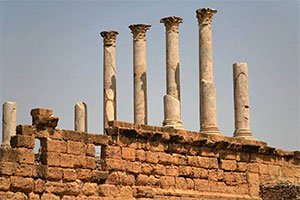Tunisia Tours: Unforgettable Tour from Carthage to Kairouan
Discover the wonders of Tunisia Tours, from the ancient ruins of Carthage to the holy city of Kairouan. Explore 3,000 years of history, culture, and stunning archaeological sites in this captivating open-air museum.
We invites you to explore an ancient civilization where art has been intricately woven into daily life.
Sought after by some of the world’s greatest empires, Tunisia is rich with archaeological wonders. From the grandeur of Carthage and Rome to the elegance of Bey residences, the landscape is dotted with amphitheaters, ancient cities, ribats, mosques, historic medinas, zaouias, and ksours ghorfas—all reflecting a land shaped by history.
Tunisia Tours from Carthage to Kairouan – Itinerary :
Day 1: Airport Tunis – Tunis
Arrival in Tunis and transfer to hotel. Dinner and overnight.
Day 2: Tunis – Bardo Museum – Carthage – Sidi Bou Said – Tunis (120 Kms)
After breakfast, departure to visit Tunis and its environs. Tunis delights and surprises the visitor ready to discover it. Its history is closely linked to that of Carthage. It became the capital in 1160 and since then did not cease to play an important role. The modern part of the city and the old Medina complement each other harmoniously.
Departure to the Bardo Museum located in a former palace of the nineteenth century Bey. Discover a few masterpieces among a rich collection of mosaics, like the mosaic of Virgil writing the Enélde, that of Lord Julius and the Triumph of Neptune. Departure to visit the archaeological site of Carthage, which has survived many invasion like the Punic, Roman, Byzantine and Vandal. Discover the Punic tophet, the Baths of Antoninus and theater. Perched on a cliff overlooking the Gulf of Carthage and Tunis, the medieval village of Sidi Bou Said is a small paradise in the colors of the Mediterranean. Over the cobbled streets, the visitor discovers the tangle of houses dressed in white lime and blue shutters moucharabiehs of Sidi Bou Said. Continue to Nabeul, visiting potters. Back in Tunis. Dinner and accommodation in a 4 stars hotel.
Day 3: Tunis – Oudna – Zaghouan – Thuburbo Majus – Tunis (230 Kms)
Departure to Oudna or Oudhna, an archaeological site located thirty kilometers south of Tunis on the road to Zaghouan. Partially excavated in the nineteenth century, excavations were resumed on the site in 1993 to reach an opening to the public in 1999.
Oudna becomes a colony of veterans during the reign of Emperor Augustus, hence the title of Colonia Iulia Pietas Tertiadecimanorum Uthina given to him and he is one of the first settlements on the territory of present-day Tunisia according to Pliny the Elder. It reached its zenith under the reign of the dynasty of the Antonines and the Severi but The site was excavated for the first time in the nineteenth century, thus revealing many mosaics, including those of a wealthy villa so-called “Laberii.
We follow the aqueduct of Zaghouan built at the time of Emperor Hadrian. It is 90 miles long and supply Carthage with water. On our way, we will see the remains of Nyphea, an imposing statue that was the cornerstone of Zaghoun. Lunch. The site Thuburbo Majus, Berber city, had sided with Carthage, which did not prevent him from becoming prosperous in Roman times, because of its position at the center of a rich agricultural region. Thuburbo Majus, with its forum, temples, baths, palestra its rich and ornate houses mosaics, is an excellent indication of what may have been the Roman cities in Africa. His remains will allow us to discuss also the period during which the country was dominated by the Vandals. Dinner and overnight in Tunis.
Day 4: Tunis – Utica – Bizerte – Tabarka (180 Kms )
Departure to Utica through the hills of Ariana and the vast plain of Medjerda. Utica is an archaeological site located at an ancient port city founded by the Phoenicians in antiquity. It is located north of present-day Tunisia, about 18 miles northwest of Carthage.
Utica, means “old town” in the Punic language (same meaning as in Arabic), it is to be contrasted with that of Carthage, meaning “new town”.
We will drive along the coast through picturesque villages until arriving in Bizerte for a lunch break. Bizerte was a naval base during French colonization that ended in 1956. At the end of our trip, we will reach Tabarka. It was a very important and active roman port from the 15th to 18th century. Coral reef and fishing was the main activity, so much so that many foreign companies (Catalonia, Sicily and Genoa) did establish their business in Tabarka.
Day 5: Tabarka – Bulla Regia – Chemtou-Tebursuk (180 Kms)
Departure to Chemtou, the former Simitthus, which was an important Numidian and later Roman site. Here, visitors can observe a stunning marble mountain with impressive quarries, renowned for producing “Numidian” or “antique yellow” marble. Overlooking this historic site, we admire a Numidian sanctuary from the second century BC, which functioned as both a prison and a workshop, operated under military oversight and imperial approval, utilizing the labor of slaves and prisoners. After a delightful lunch, we head to Bulla Regia. Conquered by Scipio Africanus in 203 BC, it became part of King Massinissa’s domain in 150 BC. This site likely served as a royal residence before its annexation by Rome. Here, we discover luxurious villas adorned with intricate mosaics, baths, temples, and a theater. Notably, some homes feature a unique two-tier architecture, including underground levels. Enjoy dinner and an overnight stay in Tebursuk.
DAY 6: Dougga – Haidra – Sbeitla ( 225 Kms)
Visit Dougga, the former Thugga. UNESCO has designated this site on the World Heritage List in 1997. The Dougga site is remarkable for its size – 70 hectares – the good preservation of monuments and historical richness of its past Punic, Numidian, Roman and Byzantine. Among the monuments that are the hallmark of Dougga are the mausoleum, the Capitol Theatre and the temples of Saturn and Juno Caelestis.
We discover the theater, still in use, and an impressive mausoleum of the second century BC. Also, a triumphal arch and a temple Capitol, dated back to 2nd century and dedicated to the three protector of Rome triad: Jupiter-Juno-Minerva Augusta … After lunch, we depart to explore the site of Haidra, the Ammaedara Roman imposing citadel of the 3rd legion of Augustus, taken over by the Byzantines. We will see the Triumphal Arch of Septimius Severus and the remains of Byzantine basilicas. Dinner and overnight in Sbeitla.
J 7: Sbeïtla – Maktar – Kairouan (200 km)
Departure to the site of Sbeitla. Formerly known as the Sufetula, it is a town in central Tunisia. Located 260 kilometers southwest of Tunis and over 150 kilometers west of Sfax. It houses one of the best preserved ancient sites in the country. The capture of the city in 647 by Arab-Muslim troops marked the birth of Ifriqiya. Then we arrive at Numidian fortress Maktar, signaling a new page of history: that of the Numidia kingdoms and their links with Rome. We will discover the Roman Baths, megalithic tombs, monuments that are still rather enigmatic “la schuela de Juvenes” and “Building Bucket” and early Christian churches. The museum illustrates the art of Numidian Maktar. Lunch. Dinner and overnight in Kairouan.
J 8 : Kairouan – El-Jem – Sousse (170 km)
The morning will be spent visiting Kairouan. First city founded in 670, North Africa, by Amir Okba ibn Nafi, when the first Muslim conquest. Kairouan is the 4th holiest city of the Muslim world. It was the capital of the province of Ifriqiyya until the eleventh century, before being destroyed by the Fatimid in 1054. The growth of coastal towns brought its decline until the eighteenth century. It took all its importance under Hussein Bey I who restored the downtown and had built many mosques.
From Basin Aghlabids, open door pool of the ninth century, , we will go to the mosque, Djama Sidi Okba, named after the founder of the city, one of the oldest places of worship of Islam, characterized by the simplicity and elegance of its architecture. Barber’s Mosque, built around the tomb of a companion of the Prophet, is a pure masterpiece of Arabic art. Finally we will have a walk in the old city and visit the souks, especially carpets shops that have made the fame of Kairouan.
After lunch, we head towards El Jem, a city founded by the Carthaginians before becoming Thysdrus the Romans, whose main richness was the production of olive oil. In this brilliant city, we admire the huge amphitheater, which compares favorably with the Colosseum in Rome. We will also visit the site museum which will allow us to feel the roman dominance of Africa. Then we will go to Sousse. Dinner and overnight in Sousse.
J 9: Sousse – Monastir – Tunis ( 130 Kms )
In Sousse, Tunisia’s third largest city, the ancient Phoenician-Punic Hadrumetum that Hannibal made his military base, we’ll go to the Grand Mosque and visit the ribat. We will then explore the museum Lamta with its rich collections of Punic and Roman polychrome mosaics showing remarkable and exceptional Christian sarcophagus. Then we will leave to Monastir for lunch. We visit the ribat Monastir and make a stop in front of the mausoleum of Habib Bourguiba. Then leave and make a Stop in Nabeul and visit the museum where, besides the Roman mosaics, we see a collection of old pottery from a sanctuary dedicated to Punic gods Baal Hammon and Tanit. Road to Tunis. Dinner and overnight in Tunis.
Day 10: Tunis – Tunis Apt
At the appointed hour, departure to airport of Tunis. Boarding formalities.
END OF PROGRAM
Included in our prices:
- Transportation by mini bus
- tour in Full board starting with dinner on day 1 and ending with breakfast on day 10
- Accommodation in 4 stars Hotel or similar
- professional guide speaking English or French or other from day 1 to day 10
- Admission and visiting museums and sites included in the program
Not included:
- Personal expenses
- Laundry
- Telephone
- Drinks during meals
- Tips to guide and drive
- All what is not mentioned in the included service.






